NCERT Solutions for Class 11 Biology Chapter 18 Body Fluids and Circulation
These Solutions are part of NCERT Solutions for Class 11 Biology. Here we have given NCERT Solutions for Class 11 Biology Chapter 18 Body Fluids and Circulation.
Question 1.
Name the components of formed elements in the blood and mention one major function of each of them.
Solution:
Blood is a mobile connective tissue composed of a fluid, the plasma and formed elements.
Formed elements includes erythrocytes, leucocytes and platelets.
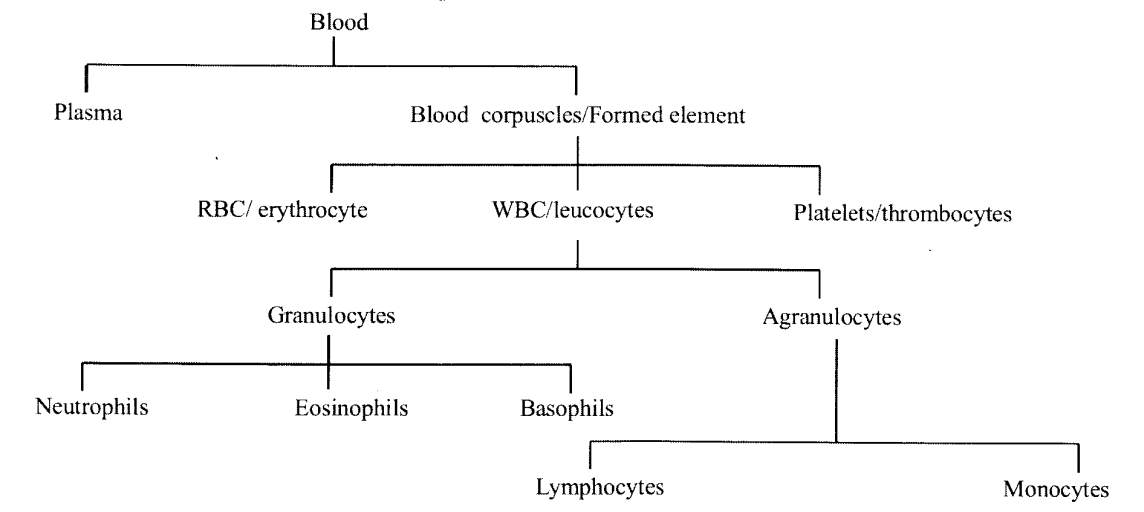
Blood corpuscles.
(a) Erythrocytes are the most prevalent corpuscles (approx. 5 to5.5 million/mm3 of blood). They contain carbonic anhydrase enzymes which help in the transportation ofCO2 and haemoglobin pigment which helps in the transportation of O2.
(b) Leucocytes lack any pigment and most active motile constituents of blood (approx. 6000-8000/ mm3 of blood). They may be of two types.
1. Granulocytes are the cells containing granules and a polymorphic nucleus.
- Neutrophils: responsible for protection against infection.
- Eosinophils: play important role in an allergic reaction.
- Basophils: significant in inflammatory reaction.
2. Agranulocytes are cells which lack granules
- Lymphocytes play a key role in immunological reactions.
- Monocytes are phagocytic in nature.
(c) Platelets: There are involved in the coagulation or clotting of blood.
Question 2.
What is the importance of plasma proteins?
Solution:
Fibrinogen, globulins and albumins are the major plasma proteins. Fibrinogen are needed for clotting or coagulation of blood. Globulins primarily are involved in defense mechanisms of the body. Albumins help in osmotic balance.
Question 3.
Match Column I with Column II:
Column I Column II
(a) Eosinophils (i) Coagulation
(b) RBC (ii) Universal recipient
(c) AB blood Group (iii) Resist infection
(d) Platelets (iv) Contraction of heart
(e) Systole (v) Gas transport
Solution:
Column I Column II
(a) Eosinophils (iii) Resist infections
(b) RBC (v) Gas transport
(c) AB blood Group (ii) Universal Recipient
(d) Platelets (i) Coagulation
(e) Systole (iv) Contraction of heart
Question 4.
Why do we consider blood as a connective tissue?
Solution:
Blood is a special connective tissue consisting of a fluid matrix, plasma, and the formed elements. It is circulated throughout the body.
Question 5.
What is the difference between lymph and blood?
Solution:
Differences between blood and lymph are as following :
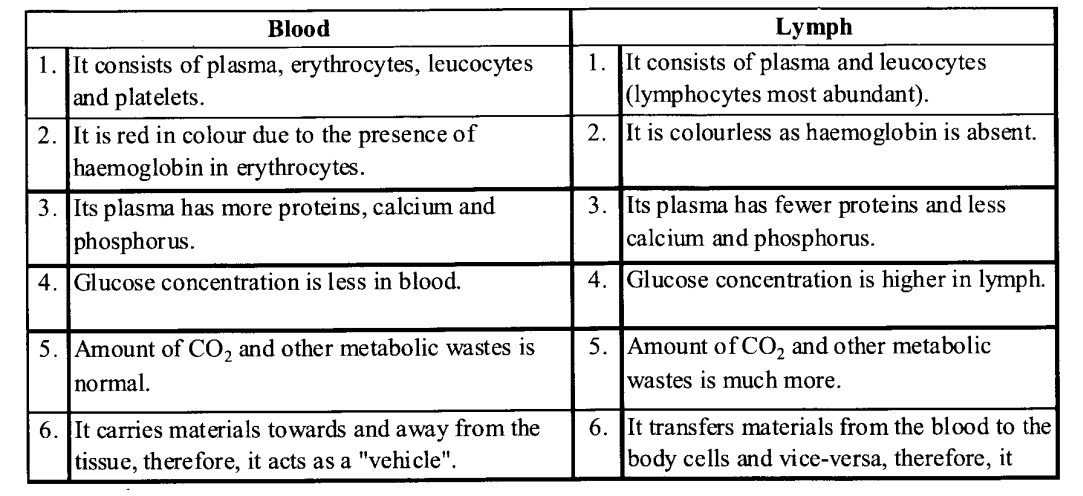
Question 6.
What is meant by double circulation? What is its significance?
Solution:
The blood pumped by the right ventricle enters the pulmonary artery whereas the left ventricle pumps blood into the aorta. The deoxygenated blood pumped into the pulmonary artery is passed on to the lungs from where the oxygenated blood is carried by the pulmonary veins into the left atrium. This pathway constitutes pulmonary circulation. The oxygenated blood entering the aorta is carried by a network of arteries, arterioles, and capillaries to the tissues from where the deoxygenated blood is collected by a system of venules, veins, and vena cava and emptied into the right atrium.
This is the systemic circulation (fig 18.1). The systemic circulation provides nutrients, O2, and other essential substances to the tissues and takes CO2, and other harmful substances away for elimination. A unique vascular connection exists between the digestive tract and liver called the hepatic portal system. The hepatic portal vein carries blood from the intestine to the liver before it is delivered to the systemic circulation. A special coronary system of blood vessels is present in our body exclusively for the circulation of blood to and from the cardiac musculature.
Question 7.
Write the differences between
(a) Blood and lymph
(b) OPen and closed system of circulation
(c) Systole and Diastole
(d) P-wave and T-wave
Solution:
(a) Differences between Blood and lymph 
(b) Differences between open and closed systems of circulation are as following :
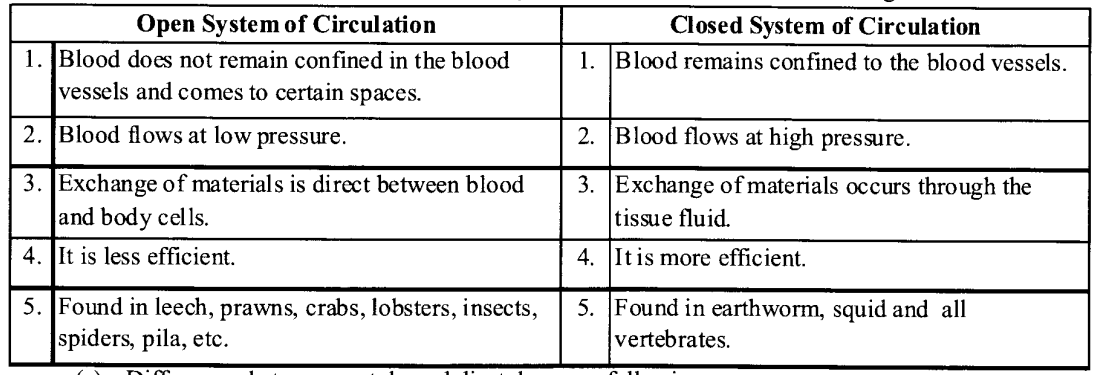
(c) Differences between systole and diastole are as following :

(d) Differences between P-wave and T-wave are as following :

Question 8.
Describe the evolutionary change in the pattern of heart among the vertebrates.
Solution:
- As it is clear from the following diagram the heart of fish has two chambers.
- This means there is no separate circulation for oxygenated and deoxygenated blood.
- There is separation of two chambers in the atrium of amphibians.
- This has further evolved to partial separation of ventricle in reptiles.
- Finally in birds there is complete separation of oxygenated and deoxygenated blood circulation with advent of four chambers in the heart.
- Mammal heart is the most developed having the most efficient double circulatory system.

Question 9.
Why do we call our heart myogenic?
Solution:
Normal activities of the heart are regulated intrinsically i.e., auto regulated by specialised muscles, hence our heart is called myogenic.
Question 10.
The sino-atrial node is called the pacemaker of our heart. Why?
Solution:
The SA node is located in the wall of right auricle slightly below the opening of the superior vena cava. It has a unique property of self-excitation which enables it to act as the pacemaker of the heart. It spontaneously initiates a wave of contraction which spreads over both the auricles more or less simultaneously along the muscle fibres.
Question 11.
What is the significance of the atrioventricular node and atrioventricular bundle in the functioning of the heart?
Solution:
Another mass of model tissue is seen in the lower left comer of the right atrium close to the atrioventricular septum called the atrioventricular node (AVN). A bundle of nodal fibers, atrioventricular bundle (AV bundle) continues from the AVN which passes through the atrioventricular septa to emerge on the top of the interventricular septum and immediately divides into a right and left bundle. These branches give rise to minute fibers throughout the ventricular musculature of the respective sides and are called Purkinje fibers. These fibers along with the right and left bundle are known as the bundle of HIS. The nodal musculature has the ability to generate action potentials without any external stimuli i.e., it is auto excitable. However, the number of action potentials that could be generated in a minute varies at different parts of the nodal system.
Question 12.
Define a cardiac cycle and the cardiac output.
Solution:
Cardiac cycle. A regular sequence of three events :
(i) auricular systole,
(ii) ventricular systole, and
(iii) joint diastole or complete cardiac diastole (relaxation ofboth auricles and ventricles) during the completion of one heart beat is known as heart cycle or cardiac cycle.
Cardiac output. The amount of blood pumped by heart per minute is called cardiac output or heart output. Heart beats 72 times per minute and pumps out about 70 ml of blood during each beat. Therefore, 72 x 70 or 5040 ml (roughly 5 liters) is the cardiac output.
Question 13.
Explain heart sounds.
Solution:
During each cardiac cycle, two prominent sounds are produced which can be easily heard through a stethoscope. The first heart sound (dub) is associated with the closure of the tricuspid and bicuspid valves whereas the second heart sound (dub) is associated with the closure of the semilunar valves. These sounds are of clinical diagnostic significance.
Question 14.
Draw a standard ECG and explain the different segments in it.
Solution:
The recording of electrical potential generated by the spread of cardiac impulse is called an electrocardiogram (ECG).
ECG is the graphic record of electronic current produced by the excitation of cardiac muscles.
A normal electrocardiogram is composed of P wave, QRS complex and T wave, P wave indicate the depolarisation of the atria. QRS complex expresses ventricular depolarisation. T wave indicates repolarization of ventricles.
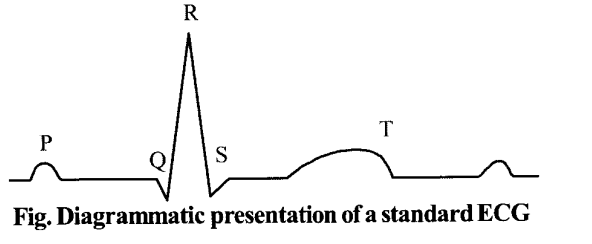
VERY SHORT ANSWER QUESTIONS
Question 1.
What is the Coagulation of Blood?
Solution:
When blood has been shed, it quickly becomes sticky and soon sets as a red jelly. This jelly or clot contracts or shrinks, and a straw-colored fluid called serum is squeezed out from it.
Question 2.
What is meant by an open circulatory system?
Solution:
When the blood does not remain confined to the blood vessels and flows into open spaces called sinus. It is termed as the open circulatory system.
Question 3.
What is the role of basophils in human body?
Solution:
Basophils are significant in allergic reactions.
Question 4.
Write down the main function of neutrophils.
Solution:
Neutrophils are mainly responsible for protection against infection.
Question 5.
What are the functions of lymphocytes?
Solution:
Lymphocytes play an important role in cell- mediated immunity.
Question 6.
What is tunica externa?
Solution:
Tunica externa is the outermost layer of blood vessels (artery and vein) made up of fibrous connective tissue with collagen fibres.
Question 7.
Mention the function of pericardial fluid.
Solution:
Pericardial fluid keeps the surface of heart moist and prevents the friction between heart wall and surrounding tissues.
Question 8.
What does the QRS complex indicate?
Solution:
QRS complex represent the ventricular depolarizations.
Question 9.
Name the most common disorder of blood circulatory system.
Solution:
Hypertension.
Question 10.
Where is tricuspid valve located? (April 87)
Solution:
The tricuspid valve is located between the right Atrium (auricle) and right ventricle.
Question 11.
Name the type of granulocytes that play an important role in detoxification.
Solution:
Eosinophils.
Question 12.
What transmits the cardiac impulse from the atria to the ventricles?
Solution:
Atrio – ventricular bundle from the atrioventricular node transmits the cardiac impulse from the atria to ventricles.
Question 13.
What is RBCs density in the blood of an adult human?
Solution:
About 5.0 – 5.5 millions/mm3 ofblood.
Question 14.
Name the reptile that has a four-chambered heart
Solution:
Crocodile.
Question 15.
What are Purkinje fibres?
Solution:
The minute branches of the right and left AV-bundles, that are found throughout the ventricular musculature of the respective sides, are called Purkinje fibres.
Question 16.
Name two vital organs affected by high blood
1. pressure or hypertension.
Solution:
Brain, kidney
Question 17.
What is the main symptom of heart failure?
Solution:
Congestion of the lungs.
Question 18.
Which vein carries oxygenated blood?
Solution:
Pulmonary vein.
Question 19.
Which is the valve present in between the left auricle and left ventricle? (April 97, M.Q.P.)
Solution:
The Bicuspid or mitral valve.
Question 20.
Which human organ is known as the “graveyard of RBCs”?
Solution:
Spleen.
SHORT ANSWER QUESTIONS
Question 1.
What are thrombocytes? Where are they produced in the human body?
Solution:
Thrombocytes or blood platelets are colourless formed elements of blood which appear round, or biconvex, or irregular and helps in clotting of blood. They are produced from the megakaryocytes (special cells in the bone marrow).
Question 2.
What is a serum?
Solution:
Serum is straw coloured fluid left after the clotting of blood. It is also called blood serum.
Question 3.
Name the different types of granulocytes. Give the function of the one of which constitutes the maximum percentage of total leucocytes.
Solution:
Granulocytes are of three types neutrophils, eosinophils, basophils.
Neutrophils constitute the maximum percentage of the total leucocyte, mainly responsible for protection against infection. They engulf the foreign substances by phagocytosis.
Question 4.
Why the closed circulatory system is more efficient than an open circulatory system?
Solution:
Advantage of closed circulatory system:
(i) Flow of blood is faster in the closed circulatory system as compared to open circulatory system. Sufficiently high blood pressure can be maintained.
- Blood does not come in contact with the tissues/organs.
- The volume of blood flowing to a particular tissue/organ can be regulated according to the need.
(ii) The blood flows under pressure so that all parts of the body receive blood with equal efficiency.
(iii) It transports materials efficiently.
(iv) There are checks for the regulation of the amount and speed of blood passing into an organ according to the requirement of that organs.
Question 5.
Name a portal system present in man. Write its one function.
Solution:
Hepatic portal system.
Significance: The blood which comes from the alimentary canal contains digested food like glucose and amino acids. The excess of glucose is converted into glycogen which is stored in the liver for later use.
Question 6.
Write down the functions of lymph.
Solution:
Functions of lymph :
(i) Lymph acts as a ‘middle man’ which transports oxygen, food materials, hormones etc. to the body cells and brings carbon dioxide and other metabolic wastes from body cells to blood.
(ii) It keeps the body cell moist.
(iii) It maintains the volume of blood.
(iv) It absorbs and transports fat and fat-soluble vitamins from the intestine.
Question 7.
Explain the chemical events taking place during clotting /coagulation of blood.
(Foreign 1997)
Solution:
An injury or a trauma stimulates the plate- 195 lets in the blood to release certain factors which activate the mechanism of coagulation. Clot or coagulam informed mainly of network threads called fibrils in which dead and damaged formed elements of blood are trapped. Fibrins are formed by the conversion of inactive fibrinogens in the plasma by the enzyme thrombin.
Thrombins, in turn are formed from another inactive substance present in the plasma called prothrombin. An enzyme complex, thrombokinase, is required for the above reaction which is formed by a series of linked enzymic reactions involving a number of factors present in the plasma in an inactive state. Calcium ions play a very important role in clotting.
Question 8.
What is an average number of thrombocytes in human blood? What is their function?
Solution:
1,50,000 to 3,50,000 platelets/mm3 of blood
– They release substances that are concerned with the clotting of blood.
Question 9.
How many chambers are present in the heart of a fish? Name them.
Solution:
There are two chambers one atrium and one ventricle. ,
Question 10.
What is meant by single circulation? Give an example.
Solution:
Single circulation
- Single circulation is the phenomenon in which the heart of an animal receives and pumps blood once for e.g. fish.
- The heart of fish is two-chambered with an atrium and a ventricle.
- The heart pumps only deoxygenated blood, to the gills for oxygenation.
Question 11.
Where and from which cells do platelets originate? What is their life span? How do they act when blood vessels get injured?
Solution:
Platelets originate from the megakaryocytes in the bone marrow.
- They live for about seven days.
- They release thromboplastins, which help convert prothrombin of the plasma into thrombin and thus they are involved in clotting of blood.
Question 12.
Explain any three disorders of the circulatory system.
Solution:
(i) High Blood Pressure (Hypertension):
Hypertension is the term for blood pressure that is higher than normal (120/80). High blood pressure leads to heart diseases and also affects vital organs like the brain and kidney.
(ii) Coronary Artery Disease (CAD):
Coronary Artery Disease, often referred to as atherosclerosis, affects the vessels that supply blood to the heart muscle. It is caused by deposits of calcium, fat, cholesterol, and fibrous tissues, which makes the lumen of arteries narrower.
(iii) Heart Failure:
Heart failure means the state of the heart when it is not pumping blood effectively enough to meet the needs of the body. The main symptoms are congestion of the lungs.
Question 13.
What is Arteriosclerosis? What are its causes?
Solution:
It is thickening, hardening and loss of elasticity of the wall of arteries. This process progressively
restricts the blood flow to one’s organs and tissues and can lead to severe health risks. It is caused by the build-up of fatty plaque, cholestrol and some other substances in and on the artery wall.
Question 14.
Define Vagus escape.
Solution:
The stimulation of vagus nerve decreases the heart rate but its continuous stimulation shows no further decrease. This is known as vagus escape.
Question 15.
What is erythroblastosis foetalis? How it occurs?
Solution:
It is a type of haemolytic disease of new-borns due to ABO blood type A, B, or O is not compatible with blood group of foetus. It develops in a foetus, when IgG molecules produced by the mother passes through the placenta.
Question 16.
Why capillaries are known as exchange vessels?
Solution:
These have very thin walls which allows the passage of nutrients from blood into body tissues. It also allows the passage of waste product came from body tissues. So, capillaries are known as exchange vessels.
Long ANSWER QUESTIONS
Question 1.
Briefly explain the cardiac cycle.
Solution:
The sequential event in the heart which is cyclically repeated is called the cardiac cycle and it consists of systole and diastole of both the atria and ventricles. Initially, all the four chambers of the heart are in a relaxed state, i.e., joint diastole. Tricuspid and bicuspid valves are open resulting in the inflow of blood into the left and right ventricles from pulmonary veins and vena cava. Semilunar valves are closed at this stage. SAN (sino-atrial node) generates an action potential resulting in simultaneous contraction of both atria – the atrial systole.
The action potential is conducted to the ventricular side by the AVN and AV bundle from where the bundle of His transmits it through the entire ventricular musculature. This causes contraction of ventricles (ventricular systole) and relaxation of atria (diastole). Ventricular Systole increases the ventricular pressure causing the closure of tricuspid and bicuspid valves. As pressure increases, the semilunar valves of the pulmonary artery and aorta are forced open, allowing blood to flow through them into circulatory pathways.
The ventricles now relax (ventricular diastole) and semilunar valves close. As the ventricular pressure declines further, tricuspid and bicuspid valves are pushed open by the pressure in the atria. The blood now once again moves freely to the ventricles. The ventricles and atria are now again in a relaxed (joint diastole) state, as earlier and the process continue. The duration of a cardiac cycle is 0.8 seconds and during this period each ventricle pumps about 70 ml of blood.
Question 2.
(a) Draw the L. S. of a human heart showing the internal structure. Label the parts of the left side of the heart and the blood vessels that enter and leave the chambers of the same side.
(b) What is the significance of the remnant of sinus venosus in the mammalian heart?
Solution:
(a)
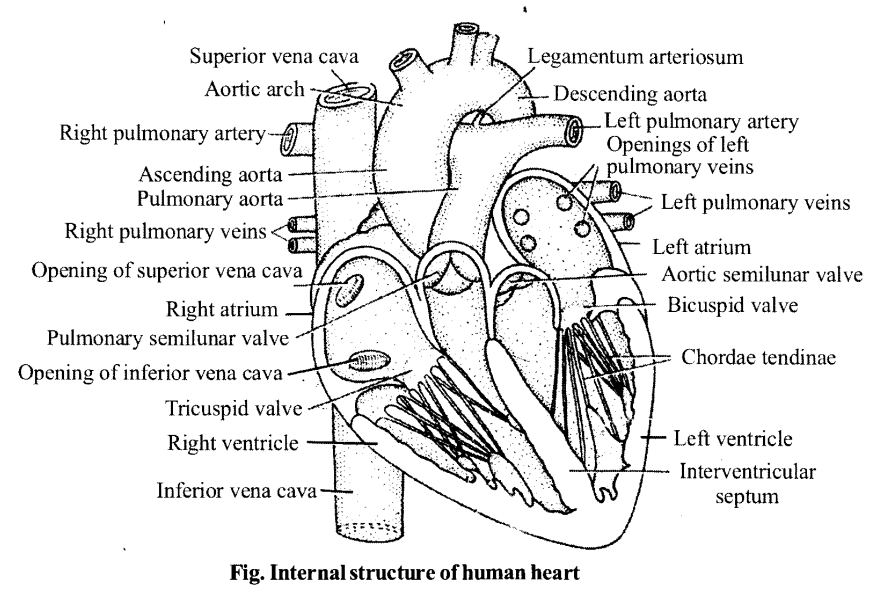
(b) It is believed that the remnant of sinus venous is modified into a sino-atrial node (SA Node) in the mammalian heart which is nothing but a mass of neuromuscular tissue laying in the wall of right atrium near the openings of the superior vena cava. It originates impulses for the regulation of the heartbeat. Thus acts as the pacemaker of heart.
Question 3.
Describe briefly the steps involved in the coagulation of blood at the site of injury of a blood vessel.
Solution:
- Blood exhibits coagulation or clotting in response to an injury or trauma.
- This is a mechanism to prevent excessive loss of blood from the body. We would have observed a dark reddish-brown scum formed at the site of a cut or an injury over a period of time.
- It is a clot or coagulum formed mainly of a network of threads called fibrils in which dead and damaged formed elements of blood are trapped.
- Fibrins are formed by the conversion of inactive fibrinogens in the plasma by the enzyme thrombin.
- Thrombins, in turn, are formed from another inactive substance present in the plasma called prothrombin.
- An enzyme complex, thrombokinase, is required for the above reaction.
- This complex is formed by a series of linked enzymic reactions (cascade process) involving a number of factors present in the plasma in an inactive state.
- An injury or a trauma stimulates the platelets in the blood to release certain factors which activate the mechanism of coagulation.
- Certain factors released by the tissues at the site of injury also can initiate coagulation. Calcium ions play a very important role in clotting.
Question 4.
Why is it necessary to check the Rh-factor of the blood of a pregnant woman?
Solution:
Rh-Factor
- Rh-antigen is present on the surface of erythrocytes in about 80-85% of human beings.
- The individuals who possess this antigen are called Rh-positive and those who do not have it are called Rh-negative.
- An Rh-negative person, when exposed to Rh-positive blood, develops anti-Rh- antibodies.
- If a pregnant woman who is Rh-negative, bears an Rh-positive foetus, will develop anti-Rh-antibodies during the first delivery when the foetal blood comes in contact with her blood.
- These antibodies linger in the blood for sufficiently long periods.
- If she carries a second foetus, that is Rh-positive, the anti-Rh-antibodies in her blood enter the foetal circulation and cause damage to the foetal RBCs, and could become fatal.
- This condition is called erythroblastosis foetalis.
We hope the NCERT Solutions for Class 11 Biology at Work Chapter 18 Body Fluids and Circulation, help you. If you have any query regarding NCERT Solutions for Class 11 Biology at Work Chapter 18 Body Fluids and Circulation, drop a comment below and we will get back to you at the earliest.